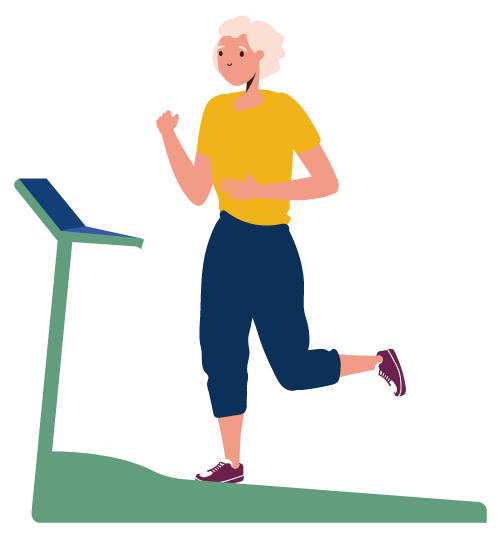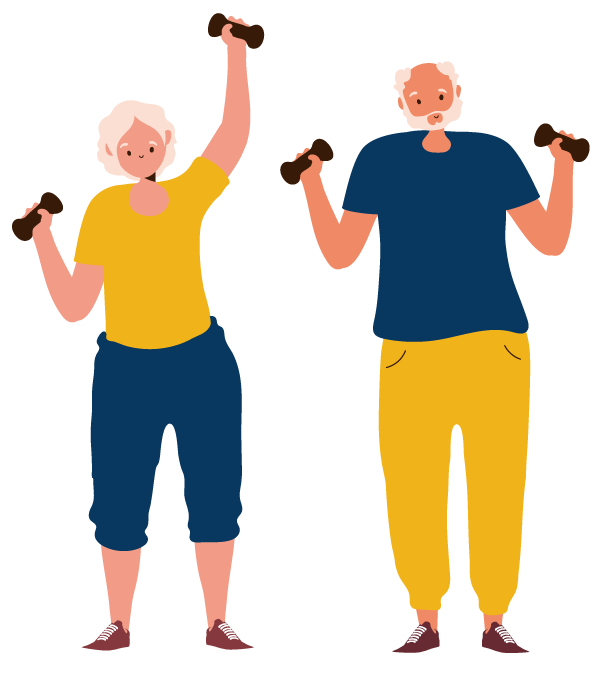Healthy Lifestyle
Different Types of Exercise
There are 4 types of physical activities, and they have different effects on our body.
Aerobic
Any activity that
- involves the use of large muscle groups (e.g. arms, legs and hips); and
- is rhythmical or repetitive in nature (e.g. the up and down motion of the legs while walking); and
- is sustainable (≥ 10 minutes).

Benefits such as
- Minimal skills required such that anybody can do it
- Enhance cardiopulmonary function and promote the health of the circulatory system
- Improve endurance
- Help with weight control
- Delay onset or prevent common diseases, e.g. heart diseases, diabetes mellitus, colon and breast cancer, dementia, fall, etc.
- Help enhance mood and improve sleep quality
Common example
Type of activity/Intensity level | Light Intensity | Moderate Intensity* | Vigorous Intensity* |
Walking | Walking slowly at home Standing | Taking a walk in the park Brisk walking Stair climbing | Jogging Running |
Housework or paid work | Sitting (e.g, using computer) Standing (e.g, cooking or washing dishes, ironing clothes) | Sweeping the floor Vacuuming Cleaning windows or cars General gardening work (e.g, grass cutting) Carrying a baby | Gardening work (Shoveling and hoeing) Carrying heavy loads (e.g. 5kg of packing rice) and walking up- or downstairs |
Recreation and sport | Drawing, Making arts and crafts, Playing music instruments | Aqua-aerobics (e.g. walking, stretching exercise in water) Catch and throw sports (e.g. Badminton, table tennis) Tai Chi | Swimming Dancing Ball games (e.g. footballs, basketballs, exercise bikes) |
*Remarks:
When performing exercise at moderate intensity, a person has a feeling of increased rate of breathing, still able to talk but not sing.
When performing exercise at vigorous intensity, a person has a feeling of rapid breathing and heart rate, must pause for a breath when speaking a short sentence.
Muscle-strengthening
Any activity that
- Involves the major muscle groups (e.g. the legs, hips, back, chest, abdomen, shoulders, arms)
- Works in a moderate to high level of intensity
Benefits such as
- Improve muscle strength
- Improve body balance and lowers risk of falling
- Help you maintain independency and perform everyday activities more easily, e.g. getting up from a chair, climbing stairs and carrying groceries
Examples of muscle-strengthening activities include:
- Weightlifting (small dumbbells or bottles filled with water)
- Wall push-ups or kneel push-ups
- Using resistance bands
- Carrying heavy loads
- Squat exercise (It is recommended to be carried out under the guidance of the coach
or with protective measures to ensure safety).
- Squat exercise (It is recommended to be carried out under the guidance of the coach

Balance
Any activity that
- Any activity that trains your balance.
Benefits such as
- Improves motor coordination, body balance, and agility; helps prevent falls and injuries for older adults.
Examples of balance activities include:
Static | single foot balance, heel-to-toe walk, toe stand (with the help of a walking aid or a stable chair) |
Dynamic | Tai chi (a “moving meditation”), Standing from a seated position, Tightrope walk, Back and side leg raise (with the help of a walking aid or a stable chair), Dancing, Bowling |
Flexibility
Any activity that
- Any activity that involves stretching muscles.
Benefits such as
- Improve flexibility and allows greater movement in joints; Makes it easier for you to bend over and tie your shoelaces
- Improve posture, relieves joint and calf stretching pain and releases muscle tension and soreness
